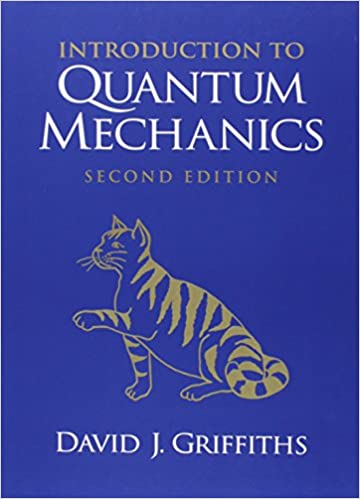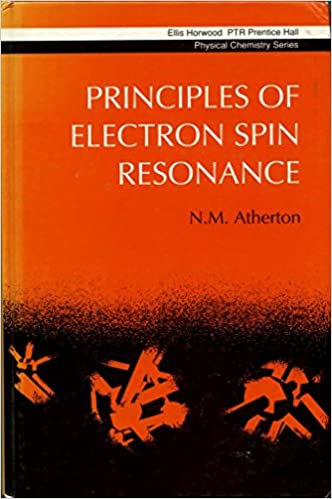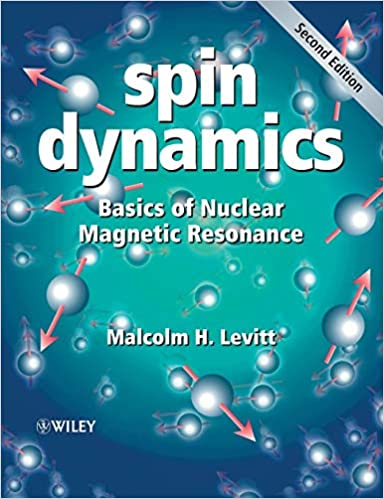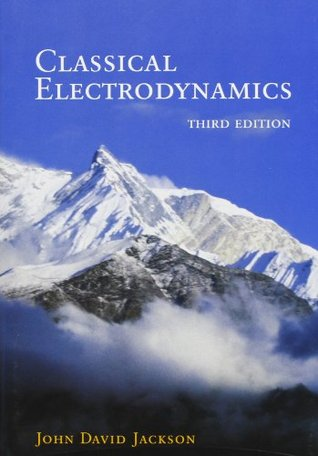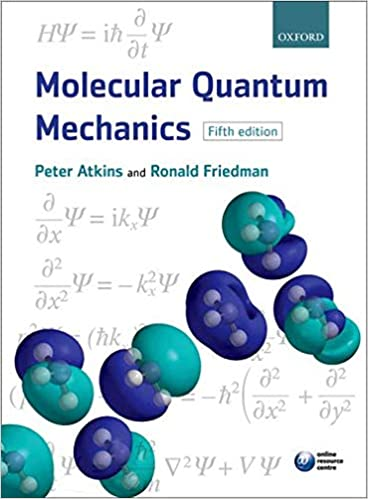When dealing with spin dynamics one considers only the spin part of the state space, not the spatial wavefunctions associated with the physical systems. This may seem odd at first, considering that the interactions between spins depend on the spatial wavefunctions, but the spatial wavefunctions can usually be integrated away thus leaving an interaction operator in the Hilbert space of the spin part of the system. This section defines the most basic spin interactions of radicals together with a brief description of their origin, thus the focus is on interactions of the unpaired electron in a radical.
The Zeeman interaction
A non-zero spin constitutes a magnetic moment, which means that it interacts with magnetic fields. The Hamiltonian describing this interaction between a magnetic moment \(\require{newcommand} \newcommand{\vc}[1]{\mathbf{#1}} \newcommand{\desc}[1]{\begin{quote}\emph{#1}\end{quote}} \newcommand{\p}{\partial} \newcommand{\bra}[1]{\langle #1 |\,} \newcommand{\ket}[1]{\,| #1 \rangle} \newcommand{\braket}[2]{\langle #1 | #2 \rangle} \newcommand{\matel}[3]{\langle #1 | #2 | #3 \rangle} \newcommand{\mexp}[1]{\langle #1 \rangle} \newcommand{\kb}[2]{| #1 \rangle\langle #2 |} \DeclareMathOperator{\Tr}{Tr} \mu = -g\mu_B\vc{S}\) and a magnetic field \(\vc{B}\) is defined as:
\begin{equation} \vc{H}_Z = -\mu \cdot \vc{B} = g\mu_B \vc{S} \cdot \vc{B} \, . \label{eq_spinHamiltonian_Zeeman} \end{equation}Here \(g\) is the Landé \(g\)-factor, \(\mu_B\) is the Bohr magneton and \(\vc{S} \equiv (\vc{S}_x , \vc{S}_y, \vc{S}_z)^T\) is the vector of spin operators, henceforth referred to simply as the spin operator.
It should be noted that the Zeeman interaction is so general that both the hyperfine and magnetic dipole-dipole interactions are special cases of this interaction. Since all of these special cases emerging from the internal structure of the spin system are treated separately, a notion will be adopted where the Zeeman interaction only refers to interactions with magnetic fields external to the spin system.
Hyperfine interactions
Some atomic nuclei possess non-zero spin and therefore has a non-zero magnetic moment. The magnetic interaction of an unpaired electron with such magnetic atomic nuclei consists of two parts known as the Fermi Contact interaction and the spin-dipole interaction. The Fermi Contact interaction originates from the orbital overlap between the electronic and nuclear wavefunctions, under the assumption that the nucleus is a point particle on the length scale of the electronic wavefunction; hence this interaction is isotropic as no structure of the nucleus is considered. The spin-dipole interaction on the other hand contributes the anisotropic part of the hyperfine interaction: This is the interaction of the magnetic moment of the electron with the magnetic field produced by the magnetic nucleus.
Mathematically the contributions to the hyperfine interaction are defined as:
\begin{align} \tilde{\vc{H}}_\text{FC} &= -\frac{g\mu_0\mu_B\gamma_N\delta(\vc{r})}{6}\vc{S} \cdot \vc{I}, \\ \tilde{\vc{H}}_\text{SD} &= \frac{g\mu_0\mu_B\gamma_N}{4\pi}\left(\frac{3(\vc{S}\cdot\vc{r})(\vc{r}\cdot\vc{I})}{|\vc{r}|^5} - \frac{\vc{S}\cdot\vc{I}}{|\vc{r}|^3}\right), \end{align}where \(\vc{I}\) is the nuclear spin operator, \(\mu_0\) is the permeability of vacuum, \(\gamma_N\) the gyromagnetic ratio of the nucleus, and \(\vc{r}\) a spatial vector pointing from the electron to the nucleus. The tilde distinguishes a Hamiltonian containing spatial coordinates from the spin Hamiltonians which are written without the tilde. The hyperfine contribution to the spin Hamiltonian can then be obtained by integrating the total hyperfine Hamiltonian over the spatial wavefunctions:
\begin{equation} \vc{H}_\text{HF} = \int \psi^\ast\chi^\ast (\tilde{\vc{H}}_\text{FC} + \tilde{\vc{H}}_\text{SD}) \psi\chi \, \text{d}\vc{r} \, . \end{equation}Here \(\psi\) and \(\chi\) are the electronic and nuclear wavefunctions, respectively. Once the integral is carried out, the hyperfine spin Hamiltonian can be written in the form:
\begin{equation} \vc{H}_\text{HF} = \vc{S} \cdot \vc{A} \cdot \vc{I}, \label{eq_spinHamiltonian_hyperfine} \end{equation}where \(\vc{A}\) is known as the hyperfine tensor (in practice this is a 3x3 symmetric real matrix).
In organic radicals the hyperfine interactions typically originate from hydrogen and nitrogen nuclei, which are spin-\(\frac{1}{2}\) and spin-\(1\) particles, respectively, while carbon and oxygen have zero spin and therefore no hyperfine interactions (this is assuming the most abundant isotopes: \(^1\)H, \(^{14}\)N, \(^{12}\)C and \(^{16}\)O). The strength of hyperfine interactions in organic radicals are typically on the order of 1 mT or less.
Magnetic dipole-dipole interaction
A radical pair consists of two unpaired electrons which each interacts with the magnetic field produced by the other electron. This interaction is in principle the same as the spin-dipole component of the hyperfine interaction, but can be much stronger due to the much larger gyromagnetic ratio of electrons compared to magnetic nuclei, since the gyromagnetic ratio depends on the inverse mass of the particle. It is also worth noting that unlike the hyperfine interaction, the magnetic dipole-dipole interaction couples the two unpaired electrons in the radical pair. The interaction Hamiltonian can be written as:
\begin{equation} \tilde{\vc{H}}_\text{DD} = \frac{g_1g_2 \mu_0 \mu_B^2}{4\pi}\left(\frac{3(\vc{S}_1\cdot\vc{r})(\vc{r}\cdot\vc{S}_2)}{|\vc{r}|^5} - \frac{\vc{S}_1\cdot\vc{S}_2}{|\vc{r}|^3}\right), \end{equation}where \(\vc{S}_1\) and \(\vc{S}_2\) are, respectively, the spin operators for the first and the second unpaired electron of the radical pair, with \(g_1\) and \(g_2\) as the corresponding \(g\)-factors. As with the hyperfine interaction, the spatial part of the Hamiltonian can be integrated away to yield the magnetic dipole-dipole spin Hamiltonian:
\begin{equation} \vc{H}_\text{DD} = \vc{S}_1 \cdot \vc{D} \cdot \vc{S}_2 \, . \label{eq_spinHamiltonian_dipoledipole} \end{equation}Although the magnetic dipole-dipole interaction defined in a very similar way to the hyperfine interaction, no contact term is included.
The exchange interaction
With a spin of \(\frac{1}{2}\hbar\), electrons are known to obey Fermi-Dirac statistics, which means, that they must also satisfy the Pauli principle - i.e. all spin-orbitals must be anti-symmetric under exchange of the electrons that occupy them. The Pauli principle can be demonstrated by defining the exchange operator, \(\vc{P}\), such that \(\vc{P}^2\psi = \psi\) for a wavefunction (or spin-orbital) \(\psi\), and the eigenvalues of \(\vc{P}\) are \(+1\) and \(-1\) for bosons and fermions, respectively (it is the particle type that determines the eigenvalue of the exchange operator, and as electrons are fermions (i.e. particles with half-integer spin), they return the negative eigenvalue under exchange). The action of the exchange operator can be illustrated with the hydrogen molecule, H\(_2\), as an example - the H\(_2\) molecule has two electrons which occupy a molecular orbital each, say \(\phi_a\) and \(\phi_b\), such that the eigenstates of the exchange operator are:
\begin{equation} \psi_\pm(\vc{r}_1,\vc{r}_2) = \frac{1}{\sqrt{2}}\left( \phi_a(\vc{r}_1)\phi_b(\vc{r}_2) \pm \phi_b(\vc{r}_1)\phi_a(\vc{r}_2) \right) \, . \end{equation}Hence these are the possible spatial wavefunctions that are simultaneous eigenstates of \(\vc{H}\) and \(\vc{P}\). Since the total states of the system should be anti-symmetric under exchange, i.e. corresponding to the eigenvalue \(-1\) of \(\vc{P}\), the total spin-orbitals are \(\psi_{+} \otimes \chi_S\) and \(\psi_{-} \otimes\chi_T\) where \(\chi_S\) is the singlet spin state and \(\chi_T\) one of the triplet states:
\begin{align} \chi_{S\phantom{0}} &= \frac{1}{\sqrt{2}}\left(\ket{\alpha\beta} - \ket{\beta\alpha}\right), \\ \chi_{T+} = \ket{\alpha\alpha}, \qquad \chi_{T0} &= \frac{1}{\sqrt{2}}\left(\ket{\alpha\beta} + \ket{\beta\alpha}\right), \qquad \chi_{T-} = \ket{\beta\beta} \, . \nonumber \end{align}With the spin-orbitals defined, note what happens when calculating the expectation value of a two-electron operator \(\vc{V}\) acting on the spatial wavefunction (the spin part of the spin-orbitals does not contribute due to normalization, i.e. \(|\chi_i|^2 = 1\)):
\begin{align} \mexp{\vc{V}}_{\pm} &= \frac{1}{2}\int \phi^\ast_a(\vc{r}_1)\phi^\ast_b(\vc{r}_2) \vc{V} \phi_a(\vc{r}_1)\phi_b(\vc{r}_2) \, d\tau + \frac{1}{2}\int \phi^\ast_b(\vc{r}_1)\phi^\ast_a(\vc{r}_2) \vc{V} \phi_b(\vc{r}_1)\phi_a(\vc{r}_2) \, d\tau \\ &\pm \frac{1}{2}\int \phi^\ast_a(\vc{r}_1)\phi^\ast_b(\vc{r}_2) \vc{V} \phi_b(\vc{r}_1)\phi_a(\vc{r}_2) \, d\tau \pm \frac{1}{2}\int \phi^\ast_b(\vc{r}_1)\phi^\ast_a(\vc{r}_2) \vc{V} \phi_a(\vc{r}_1)\phi_b(\vc{r}_2) \, d\tau \, , \nonumber \end{align}where the integration is over all 6 spatial coordinates. Thus the Coulomb interaction between the electrons, for example, is:
\begin{align} \mexp{\vc{V}}_{\pm} &= \frac{e^2}{4\pi\varepsilon_0} \left( \int |\phi^\ast_a(\vc{r}_1)|^2 |\phi^\ast_b(\vc{r}_2)|^2 \frac{1}{r_{12}} \, d\tau \pm \int \phi^\ast_a(\vc{r}_1)\phi^\ast_b(\vc{r}_2) \frac{1}{r_{12}} \phi_b(\vc{r}_1)\phi_a(\vc{r}_2) \, d\tau \right) \\ &= K \pm J \, . \nonumber \end{align}Here \(K\) is the actual Coulomb integral, and \(J\) is known as the exchange integral. Thus there is an energy difference of \(2J\) between the two spin-orbitals, and in particular this means that the energy of the spin singlet state is \(2J\) lower than the energy of the spin triplet states, due to the anti-symmetrization requirement of the total spin-orbital wavefunction. This energy difference between the spin states can be incorporated in the spin Hamiltonian through an exchange-term of the form:
\begin{equation} \vc{H}_{ex} = -2J \, \vc{S}_1 \cdot \vc{S}_2 \, . \label{eq_H_exchange} \end{equation}The spin operator product \(\vc{S}_1 \cdot \vc{S}_2\) has eigenvalues \(-\frac{3}{4}\hbar^2\) for singlet and \(+\frac{1}{4}\hbar^2\) for triplet, so the form of Eq. (\ref{eq_H_exchange}) does indeed ensure that the singlet state energy is \(2J\) lower than for triplet. Finally, note that \(J\) in principle will contain more than just the contribution from the Coulomb interaction, and might even contain anisotropic terms, but in general the Coulomb contribution will be the dominant term. Also, even though it is usually referred to as the exchange interaction, it is rather a quantum mechanical effect than an actual interaction.
Additional contributions to the spin Hamiltonian
In addition to the most common terms in the spin Hamiltonian, other types of interactions exist as well. One such interaction is the nuclear quadrupole interaction: An atomic nucleus with a spin quantum number greater than \(\frac{1}{2}\) may have a charge distribution that is not spherically symmetric (this can be shown using the Wigner-Eckart theorem) and, therefore, possess an electric quadrupole moment. This quadrupole moment is coupled to the spin of the nucleus through an interaction of the form:
\begin{equation} \vc{H}_Q = \vc{I} \cdot \vc{P} \cdot \vc{I}, \end{equation}where \(\vc{I}\) is the nuclear spin operator interacting with itself through the quadrupole coupling tensor:
\begin{equation} \vc{P} = \frac{q}{2I(2I - 1)\hbar}\vc{V} \, . \end{equation}Here \(q\) is the nuclear charge, \(I\) the nuclear spin quantum number and \(\vc{V}\) is the electrostatic field gradient tensor. It should be noted that the nuclear quadrupole interaction does not interact directly with any other spins, but it could, for example, still have an effect on the dynamics of a radical pair through a hyperfine interaction. The effect of the quadrupole interaction on radical pair spin dynamics is then limited by the strength of the corresponding hyperfine interaction.
Similar to the nuclear quadrupole interaction, a second-order spin-spin interaction also exists for the electronic spins, known as the zero-field splitting:
\begin{equation} \vc{H}_{ZF} = \vc{S} \cdot \vc{D} \cdot \vc{S}, \end{equation}where \(\vc{S}\) is the electronic spin operator and \(\vc{D}\) the zero-field splitting tensor. The interaction is often put in a different form:
\begin{equation} \vc{H}_{ZF} = D\left(\vc{S}_z^2 - \frac{1}{3}\vc{S}^2\right) + E(\vc{S}_x^2 - \vc{S}_y^2), \end{equation}using the definitions:
\begin{equation} D = \vc{D}_{zz} - \frac{1}{2}(\vc{D}_{xx} + \vc{D}_{yy}), \qquad E = \frac{1}{2}(\vc{D}_{xx} - \vc{D}_{yy}) \, . \end{equation}Like the nuclear quadrupole interaction, the zero-field splitting only appears for electronic spin quantum numbers greater than \(\frac{1}{2}\), and may be significant in systems with several unpaired electronic spins, such as transition metal complexes.
Finally, it should be noted that the \(g\)-factor, introduced as a part of the spin magnetic moment of the electron in Eq. (\ref{eq_spinHamiltonian_Zeeman}), can be replaced by a \(g\)-tensor, \(\vc{g}\). This is often done when other effects such as spin-orbit coupling needs to be included in the spin chemical model.
